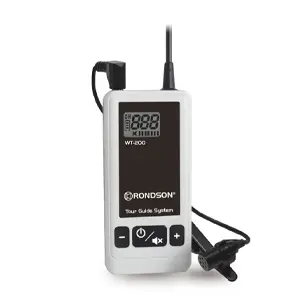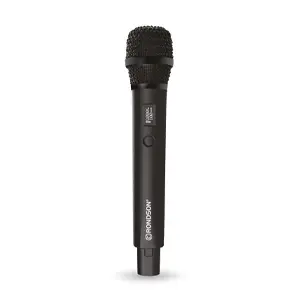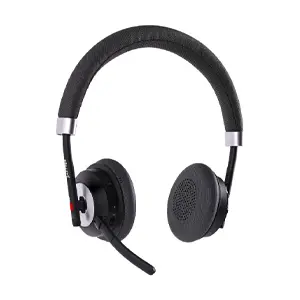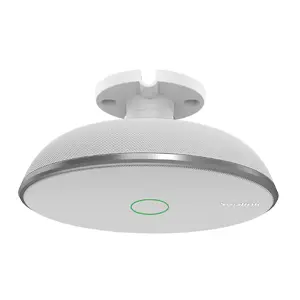
CONFERENCE MICROPHONE: WHAT YOU NEED TO KNOW TO CHOOSE THE RIGHT ONE
Are you fed up with your laptop's microphone? With sound output that generally lacks quality, it has been relegated to "spare tire" status... The reasons? The incessant growth of content creation ( podcasts, radio... ), but above all the arrival of the virtual world for professional communication.
Video conferencing favorites are now external microphones. After all, we always say that video conferencing is communication, right? So microphones have a priority role: they are what allow everyone attending the meeting to hear each other clearly, participate actively and stay engaged.
Ready to take the step? Here's a step-by-step guide to help you find the perfect microphone. ↓
TABLE MICROPHONE, HANDHELD MICROPHONE... WHICH SHOULD YOU CHOOSE?
Wired or wireless, today, when we talk about microphones, we are not necessarily referring to the handheld accessory that is a singer's indispensable ally. Portable, desktop or even ceiling mounted, there is something for everyone! But although they all have the main function of transmitting audio in space, they are not designed for the same use ( far from it ):

Portable: Lapel microphones, "Madonna" microphones, here we address everything related to mobility ( one-man shows, tourism, presentations, etc. )

Handheld microphone: A classic, it can be used on any occasion, as long as you want to move freely. For presentations or professional talks, allow multiple speakers to take turns speaking.

Headphones: Since we are in the professional sector, headphones are the best! Who are they aimed at? Mobile professionals who move between the office, home, the airport, the train and many other places during the work week.

Tabletop: Individual ( gooseneck ), or collective ( speaker ), used mainly for radio, large events and in small and medium-sized fixed collaboration spaces.

Ceiling mounting: Thanks to its more global sound capture, it is perfectly compatible with large conference rooms. Plus, it allows you to make the most of your space!
Not sure which audio tool to choose? We've put together a speaker VS headphones comparison to help you decide (it's right here !)
What technical requirements must be taken into account?
Headphones, speaker, handheld microphone, camera or even webcam... the saying goes: don't buy just to buy! As with any purchase, it is best to sit down and think about your needs and preferences. But still, there are some technical factors that should not be ignored... What are they? Below we review the most important ones:
Sound quality: refers to the device's ability to capture the sound to be transmitted. HD, Hifi, Ultra HD, Hi-Res, 3D... There are dozens of names for audio quality! Fortunately, there are 3 that stand out from the rest:
- Standard Audio: This is the basic option for regular video conferencing use. Your weak point? Sound clarity, often limited by less advanced signal reception.
- High Definition ( HD ) Audio – Doubles the quality of standard audio. In terms of accuracy and clarity, HD audio greatly improves understanding and communication.
- Ultra High Definition ( UHD ) Audio – It's the ultimate in audio quality! Voice reproduction, fluency, etc. Ultra HD audio is up to 10 times better than standard service quality.
The type of microphone: Now that we have seen the different types of microphone, let's look at the types of microphone! What is the difference between them? Here we refer to the way the microphone picks up audio in space:
- Omnidirectional microphones: offer global sound coverage thanks to 360° pickup . It is the ideal option for meetings with several people in a room, as it allows everyone to hear each other clearly.
- Directional microphones: Bidirectional ( 180° ) or unidirectional ( 90-120° ), they focus their attention on a specific area. They are very popular in noisy environments as they reduce background noise and focus on the main sound source - the speaker!
- Matrix microphones: they are the best in terms of precision and intelligibility. Why are they so good? They use several microphone elements to collect sound in different directions and form a sound beam.
Noise reduction: passive or active? Hearing your neighbors cough or typing on their keyboards isn't necessarily to the liking of distant participants... So if you want your meeting to be a success, don't underestimate the importance of noise reduction. Passive or active, we are going to tell you everything right now:
- Passive noise reduction : It is the combination of design techniques and materials to minimize noise by preventing its propagation. Microphones are designed with anti-interference external housings, acoustic filters or an echo cancellation system.
- Active Noise Reduction ( ANC ) : Uses cutting-edge electronic technology to reduce unwanted noise in real time. Simply put, microphones pick up ambient sound and send it to the system for processing. Anti-noise signals are then generated to cancel it out.
The range and direction of sound: Let's keep it simple! Range is the intensity of the microphone in decibels. In other words, it is the maximum distance at which the microphone is capable of picking up voices. Directionality is the direction from which the acoustic wave ( signal ) reaches the microphone. There are 3 ( yes, we digress a little ):
- Omnidirectional: Captures voices coming from all directions, 360°.
- Bidirectional: Focuses on a defined horizontal or vertical audio range, 180°.
- Unidirectional: Highlights the main speaker's voice by capturing at 90-120°.
Note: The larger the meeting room, the more microphones you will need.
HOW MUCH DOES A VIDEO CONFERENCE MICROPHONE COST?
We cannot give you an exact price for a video conferencing microphone as it varies depending on several factors: quality, brand, features, USB or Bluetooth connection, etc. However, we can give you a price range for each type of video conferencing microphone:
Microphones integrated into webcams: This is the least expensive option and, in general, the most practical for teleworking ( if you don't like to travel ). For between €80 and €100 ( depending on the quality and functions required ), you can get a complete audio and video conferencing equipment.
Microphones with USB connection: Expect to pay between €45 and €130 for an external wired professional audio module. If you prefer a high-end USB model, you will have to shell out between €130 and €250 .
Superior conference microphones – For larger meeting rooms, or to meet specific needs, there are more sophisticated models with advanced features. They can cost up to several hundred euros, depending on the brand and the options they include.






